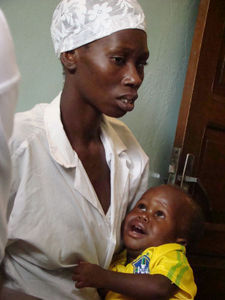Advertisement

 The Clinic
The Clinic
A malnourished mother and child present at The Salvation Army’s Health and Nutrition Clinic in Port-au-Prince. Today we spent all morning filming at The Salvation Army’s Health and Nutrition Clinic inside the compound at Port-au-Prince. The clinic opens at 8am but when we walked around the corner to the entrance at 7:30 there was already a crowd of more than 50 people lining the “waiting room” benches under a shelter outside the facility! The clinic is mainly for mothers, babies and young children, but because it is one of the cheapest health facility in the city, adults who can’t afford to go anywhere else are also treated.
The clinic is a great example of how The Salvation Army runs in Haiti. It is not just a service but a ministry. Every morning before the doors open the clinic staff have a time of devotion with the waiting patients. They sing, read a Bible verse and pray. After that while the first batch of patients head into the facility, a clinic nurse conducts an educational seminar with those remaining. Some of the topics taught are how to prevent diseases and infections that are common to Haiti, how to sterilise water etc. Inside the clinic is packed. Nurses administer vaccinations to a line of kids who have

 The Clinic 2
The Clinic 2
Patients in the “waiting room” are taught how to prevent prevalent diseases such as malaria and TB, as well as how to sterilise water.come over from The Salvation Army’s primary school next door, others weigh and measure babies, others take blood tests from pregnant mothers. Babies who are diagnosed with malnutrition are offered to participate in the Clinic’s nutrition programme where they are given a bottle mix of milk, oil and sugar. It is a truly holistic ministry that runs seamlessly with a small staff of one doctor and a team of cheerful and dedicated nurses.
Many of the patients we saw had symptoms of malaria. Almost half of the children we saw were either malnourished at the time, or had been malnourished in the past - the clinic’s Doctor, Danielle, showed us how to identify the characteristic reddish tinge and thinning of the hair around their temples. A few of the others were sent of to have tests for TB. It’s sad to think that all of these conditions are preventable but are still flourishing in areas of such poverty.
After the clinic we went next door to the Divisional Headquarters compound to film the daily feeding program. The Salvation Army feeds about 50 elderly people every weekday - for most it is probably the only meal they’ll eat that

 next door to the clinic
next door to the clinic
The reason why water sterilisation in Haiti is so important.day. Many of them are homeless with no access to money, let alone the facilities to prepare and cook food.
Later that afternoon we toured The Salvation Army’s orphanage, located just next door to where we are staying. The orphanage houses 50 children, ranging in age from six to 22. They’re great kids - really robust and eager to hold your hand and practice their English. The orphanage also supports 250 kids in the community by helping out with their school fees, running after-school care and providing supper for those children that would go hungry at home.
It’s fair to say that The Salvation Army in Port-au-Prince is the hub of the community it is part of. Hundreds of people pass through the compound every day, with the Army meeting their physical and spiritual needs.
Advertisement
Tot: 0.127s; Tpl: 0.011s; cc: 5; qc: 44; dbt: 0.0329s; 1; m:domysql w:travelblog (10.17.0.13); sld: 1;
; mem: 1.1mb

 The Clinic
The Clinic
 The Clinic 2
The Clinic 2
 next door to the clinic
next door to the clinic
